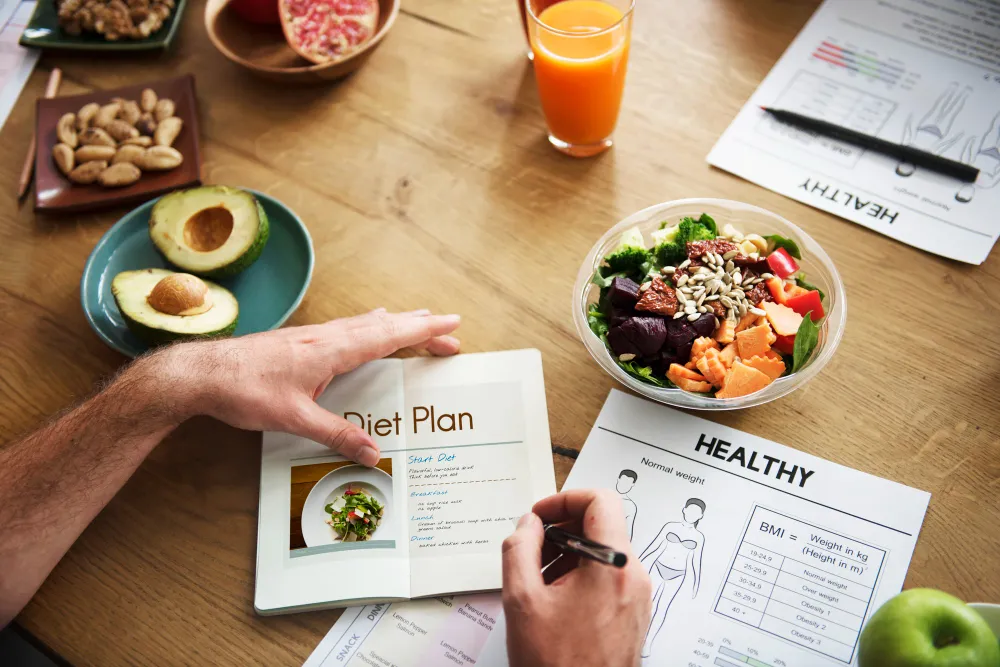It is very possible to get down with a personalized fitness and nutrition plan and, of course, discover how personalized plans tailor workouts and meals to YOUR body, goals, and lifestyle, because you’re one of a kind, and your plan should be too!

Ever feel like generic fitness and nutrition advice just doesn’t work for you? You’re not alone! Everyone’s body, goals, and lifestyle are different.
Now, let’s look at why a customized fitness and nutrition plan is so potent. Let’s break down how a plan works and why it might be the key to your best self.
What is a Personalized Fitness and Nutrition Plan?
An individualized plan is more like a personally designed road map. It takes into account your unique needs, preferences, and goals in order to make a fitness and nutrition plan that fits your lifestyle.
Instead of having a predetermined plan, you get one specifically designed for your body, hectic lifestyle, and tastes.
How Does It Work?

This is a step-by-step explanation of how individualized plans are completed and why they work so great:
1. Evaluation: Getting to Know YOU
The first step is all about knowing you. A fitness trainer, dietician, or online software will ask the following questions:
- What do you wish to achieve? (e.g., weight reduction, muscle growth, increased energy)
- What is your current fitness level?
- Do you have any conditions or injuries?
- How is your day structured?
- What do you like (or hate) to eat?
- What is your budget for food or gym membership?
This feedback helps create structure for YOU: a realistic and achievable plan.
2. Goal Setting: What Do You Want to Achieve?
Next, your coach or trainer will help you create effective, concrete goals. For example:
– “I want to achieve 10 pounds of weight loss in 3 months.”
– “I want to run a 5K without stopping.”
– “I want increased energy throughout the day.”
Having a goal in mind makes it simpler to track progress and stay motivated.
3. Fitness Plan: Workouts That Fit Your Life
Your fitness plan will be based on your goal, fitness level, and available time. This is what it could include:
– Exercise Type: cardio, strength training, yoga, or a mix of these.
– Intensity: How intense you need to exercise based on your fitness level.
– Frequency: How often you need to exercise.
– Duration: How long each workout should be.
– Equipment: Whether you’ll use gym machines, free weights, or just your body weight.
For example, if you’re a busy parent with only 30 minutes a day to spare, your plan might include quick, high-intensity workouts. If you’re training for a marathon, it’ll focus on building endurance.
4. Nutrition Plan: Food That Fuels Your Goals
Your nutrition plan is just as important as your training plan. It’s meant to be giving your body what you need in order to do what you want. This is what it might look like:
– Calorie Needs: How many calories you should be taking in for what reason (i.e., losing weight, maintenance, or bulking up)?
– Macronutrients: What ratios of carbs, protein, and fat you should be taking in in your body?
– Timing of Meals: When to have meals for greatest energy and recuperation.
– Food Choices: Meal suggestions and recipes that make use of favorite foods.
– Dietary Limitations: Adjustments for allergies, intolerances, or lifestyle considerations (e.g., vegan, gluten-free).
For example, if your goal is building muscle, the plan might suggest extra protein-containing foods like chicken, eggs, and beans. If your aim is weight reduction, it could focus on portions and low-calorie, dense-nutrient foods.
5. Keeping Track: Staying on Course
A good individualized plan has ways of tracking your progress. This may involve:
– Tracking Fitness: Keeping a log of your workout, weights lifted, or miles run.
– Nutritional Tracking: Keeping a food diary to notice if you’re adhering to your plan.
– Body Measure Tracking: Following changes in weight, body fat, or muscle.
– The Way You Feel: Noticing more energy, better mood, or added strength.
Monitoring enables you to see what’s successful and where adjustments might be necessary.
6. Adjustments: Improving the Plan
Throughout the process, your plan will evolve. Examples include:
– If you’ve plateaued in losing weight, your coach will adjust your calorie intake or intensity of exercise.
– If you’re tired, they’ll suggest more rest or changes to your diet.
– If you achieve a goal, they’ll help you set new ones to keep pushing yourself.
This flexibility is what allows personalized plans to be successful.
Why Personalized Plans Work Better
Here’s the reason a personalized plan beats a general one any day:
1. It’s Tailored to YOU
It works with your body, goals, and lifestyle.
2. It’s Realistic
It is established in comparison to your schedule, likes, and limits.
3. It’s Adaptable
It can be changed as your needs change.
4. It Keeps You Energized
Witnessing progress towards your goals is very motivating.
How to Get Started
Ready to create your own tailored plan? Here’s how:
1. Consult a Professional
Hire the services of a personal trainer or a nutritionist who can craft a plan especially for you.
2. Use an App
Most fitness and nutrition apps give personalized plans based on your details.
3. DIY
If you have an idea of what you’re doing, you can create your own plan with online resources and tools.
Last Words
A personalized fitness and nutrition plan is like having a GPS for your health journey—it guides you step by step, adjusts to your needs, and leads you to your destination.
Whether you need to lose weight, build muscle, or just feel better, a plan that’s designed for you can make the difference.
So, farewell to the one-size-fits-all and hello to a plan that’s as unique as you are. Your body, your goals, your rules, let’s do this.
